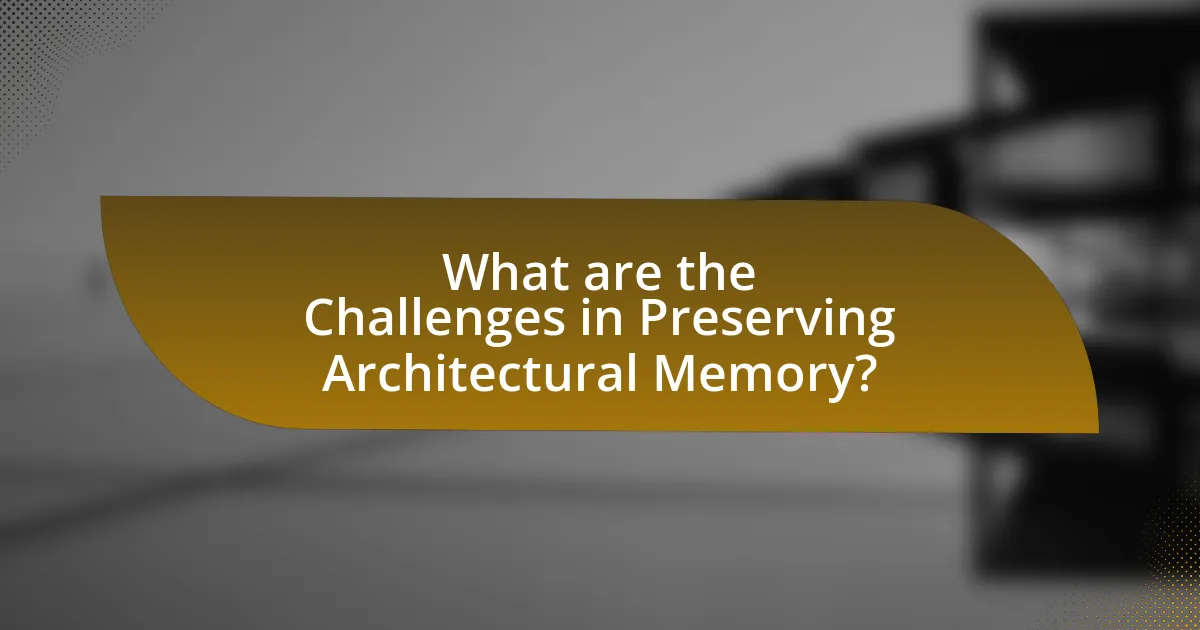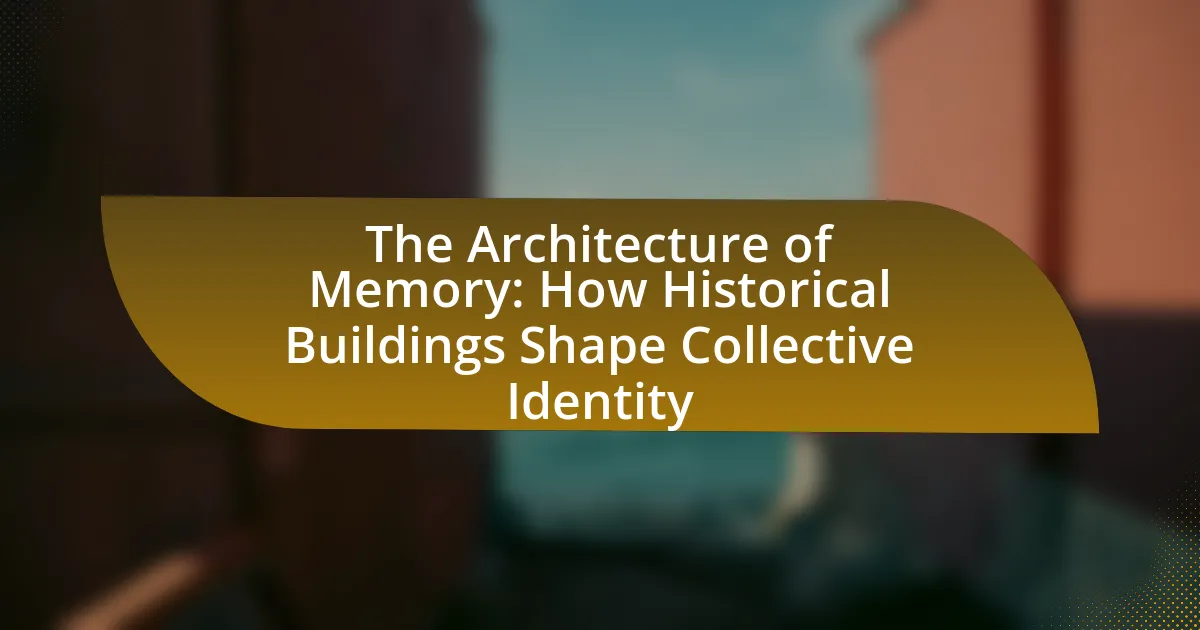The Architecture of Memory examines how physical spaces, particularly historical buildings and monuments, evoke collective memories and cultural identities within communities. It highlights the role of these structures in preserving shared experiences and values, influencing social cohesion and identity formation. The article discusses how historical buildings contribute to collective identity, the elements of architecture that evoke memories, and the varying interpretations of architectural memory across cultures. Additionally, it addresses the importance of memory in architecture, the impact of nostalgia, and the challenges faced in preserving architectural heritage, while also exploring strategies for community engagement and advocacy in preservation efforts.

What is the Architecture of Memory?
The Architecture of Memory refers to the design and structure of physical spaces that evoke collective memories and cultural identities. This concept emphasizes how historical buildings and monuments serve as tangible representations of shared experiences, values, and narratives within a community. For instance, structures like memorials or heritage sites are intentionally created to preserve and communicate the history and identity of a group, influencing how individuals relate to their past. Research indicates that these architectural forms can significantly impact social cohesion and collective memory, as they provide a focal point for remembrance and reflection, thereby reinforcing a community’s identity over time.
How do historical buildings contribute to collective identity?
Historical buildings contribute to collective identity by serving as tangible representations of a community’s shared history and cultural values. These structures often embody significant events, architectural styles, and social narratives that resonate with the collective memory of a population. For instance, landmarks like the Colosseum in Rome or the Great Wall of China symbolize national pride and historical continuity, reinforcing a sense of belonging among citizens. Additionally, studies have shown that communities with preserved historical sites report higher levels of social cohesion and identity, as these buildings foster a connection to the past and a shared understanding of cultural heritage.
What elements of architecture evoke memories in communities?
Architectural elements such as historical buildings, public spaces, and cultural landmarks evoke memories in communities. These structures often serve as physical representations of shared history and collective identity, reinforcing community bonds. For instance, the preservation of historical buildings like town halls or churches can trigger nostalgia and a sense of belonging among residents, as they often symbolize significant events or milestones in the community’s past. Research indicates that communities with well-maintained historical architecture report higher levels of civic pride and social cohesion, demonstrating the powerful role these elements play in memory formation and community identity.
How do different cultures interpret architectural memory?
Different cultures interpret architectural memory as a reflection of their historical narratives and collective identities. For instance, in Western cultures, monumental structures like cathedrals and government buildings often symbolize national pride and historical continuity, serving as reminders of significant events and figures. In contrast, Indigenous cultures may view architectural memory through the lens of spirituality and connection to the land, where structures like sacred sites embody ancestral stories and cultural practices. Research by David Lowenthal in “The Past is a Foreign Country” highlights how memory is embedded in architecture, influencing how communities perceive their heritage and identity. This demonstrates that architectural memory is not merely about physical structures but also about the meanings and values that different cultures ascribe to them.
Why is the concept of memory important in architecture?
The concept of memory is important in architecture because it helps to create a sense of identity and continuity within communities. Architectural structures often serve as physical embodiments of collective memories, reflecting historical events, cultural practices, and shared experiences. For instance, buildings like the Parthenon in Athens symbolize ancient Greek democracy and cultural heritage, reinforcing the collective identity of the nation. This connection between memory and architecture fosters a deeper understanding of a community’s past, influencing how individuals relate to their environment and each other.
What role does nostalgia play in the perception of historical buildings?
Nostalgia significantly influences the perception of historical buildings by evoking emotional connections and memories associated with the past. This emotional response can enhance the appreciation and value individuals place on these structures, as they often symbolize cultural heritage and collective identity. Research indicates that nostalgia can lead to a heightened sense of belonging and continuity within a community, reinforcing the importance of preserving historical architecture. For instance, studies have shown that individuals who experience nostalgia are more likely to support heritage conservation efforts, as they view historical buildings as vital links to their personal and communal histories.
How does memory influence the preservation of architectural heritage?
Memory significantly influences the preservation of architectural heritage by shaping collective identity and cultural significance. When communities remember and value their historical buildings, they are more likely to advocate for their protection and restoration. For instance, the preservation of the Notre-Dame Cathedral in Paris was driven by its deep-rooted significance in French history and collective memory, leading to widespread public support and funding for its restoration after the 2019 fire. This connection between memory and preservation is further evidenced by studies showing that places with strong historical narratives often receive greater attention and resources for conservation efforts, highlighting the role of shared memory in maintaining architectural heritage.

How do Historical Buildings Shape Collective Identity?
Historical buildings shape collective identity by serving as tangible symbols of a community’s history, culture, and values. These structures often embody significant events, architectural styles, and social narratives that resonate with the collective memory of a population. For instance, the Parthenon in Athens represents ancient Greek democracy and cultural achievement, reinforcing national pride and identity among Greeks. Similarly, the preservation of historical sites, such as the Berlin Wall, fosters a shared understanding of past struggles and triumphs, influencing contemporary social cohesion and identity formation. Through their historical significance and cultural resonance, these buildings become focal points for collective memory, shaping how communities perceive themselves and their heritage.
What are the mechanisms through which architecture influences identity?
Architecture influences identity through its ability to shape social interactions, evoke emotional responses, and reflect cultural values. The design and layout of buildings can foster community engagement, as seen in public spaces that encourage gatherings and socialization, thereby reinforcing a sense of belonging. Additionally, architectural styles and materials often symbolize cultural heritage, as evidenced by historical landmarks that serve as reminders of a community’s past and shared experiences. For instance, the preservation of Gothic cathedrals in Europe not only showcases architectural grandeur but also connects individuals to their historical and cultural roots, reinforcing collective identity. Furthermore, architecture can influence personal identity by providing a sense of place and belonging, as individuals often associate specific environments with their life experiences and memories.
How do public spaces foster a sense of belonging?
Public spaces foster a sense of belonging by providing environments where individuals can gather, interact, and engage in community activities. These spaces, such as parks, plazas, and community centers, serve as venues for socialization, cultural expression, and shared experiences, which are essential for building social ties. Research indicates that well-designed public spaces encourage participation and inclusivity, allowing diverse groups to come together, thereby enhancing community cohesion. For instance, a study by the Project for Public Spaces highlights that vibrant public spaces can lead to increased social interactions and a stronger sense of community identity, reinforcing the idea that these areas are integral to fostering belonging among residents.
What impact do monuments have on national identity?
Monuments significantly shape national identity by serving as symbols of cultural heritage and collective memory. They embody historical narratives and values that unite citizens, fostering a sense of belonging and pride. For instance, the Lincoln Memorial in the United States not only commemorates President Abraham Lincoln but also represents ideals of freedom and equality, influencing American identity and civic values. Research indicates that monuments can reinforce social cohesion and national unity, as seen in studies highlighting how memorials contribute to collective remembrance and identity formation among diverse populations.
In what ways do historical buildings reflect societal values?
Historical buildings reflect societal values through their architectural styles, functions, and the narratives they embody. For instance, the grandeur of cathedrals like Notre-Dame de Paris illustrates the importance of religion in medieval society, while the design of government buildings, such as the U.S. Capitol, signifies democratic ideals and civic pride. Additionally, monuments like the Lincoln Memorial in Washington, D.C., represent collective memory and values such as equality and justice, reinforcing societal aspirations. These structures serve as physical manifestations of cultural priorities, historical events, and community identity, thereby providing insight into the values held by societies at different points in time.
How does architectural style convey cultural significance?
Architectural style conveys cultural significance by reflecting the values, beliefs, and historical context of a society. For instance, Gothic architecture, characterized by its pointed arches and intricate details, emerged in medieval Europe and symbolizes the era’s religious devotion and social hierarchy. This style not only served functional purposes but also communicated the cultural importance of the church and the community’s collective identity during that period. Similarly, the use of indigenous materials and traditional designs in vernacular architecture illustrates a community’s connection to its environment and heritage, reinforcing cultural identity. Thus, architectural styles serve as tangible representations of cultural narratives and collective memory.
What stories do historical buildings tell about their communities?
Historical buildings narrate the cultural, social, and economic histories of their communities. These structures often reflect the architectural styles, materials, and construction techniques prevalent during their time, showcasing the community’s values and priorities. For instance, the presence of a grand courthouse may indicate a community’s emphasis on justice and governance, while a historic factory can reveal the industrial heritage and economic activities that shaped local livelihoods. Additionally, buildings often serve as landmarks that foster a sense of identity and continuity, linking generations through shared experiences and memories. The preservation of these sites can also highlight community efforts to maintain heritage, as seen in initiatives to restore and repurpose old structures, thereby reinforcing local pride and collective identity.

What are the Challenges in Preserving Architectural Memory?
The challenges in preserving architectural memory include deterioration of materials, changing urban landscapes, and insufficient funding for restoration projects. Deterioration occurs due to environmental factors such as weathering, pollution, and neglect, which can lead to irreversible damage to historical structures. Changing urban landscapes often result in the demolition or alteration of buildings that hold cultural significance, undermining their historical context. Additionally, insufficient funding limits the ability of preservation organizations to maintain and restore these structures, as evidenced by the National Trust for Historic Preservation reporting that many sites face financial constraints that hinder their upkeep. These factors collectively threaten the integrity and continuity of architectural memory.
How do modern developments threaten historical buildings?
Modern developments threaten historical buildings primarily through urbanization, which often leads to demolition or alteration of these structures. As cities expand, the demand for new infrastructure and housing can result in the destruction of historical sites to make way for modern constructions. For instance, in cities like London and Paris, significant historical landmarks have been compromised or replaced by high-rise buildings, undermining their cultural significance. Additionally, the use of incompatible materials and construction techniques in nearby developments can negatively impact the structural integrity and aesthetic value of historical buildings, as seen in various heritage sites across Europe. This ongoing trend not only erodes the physical presence of historical architecture but also diminishes the collective identity and memory associated with these sites.
What are the consequences of neglecting architectural heritage?
Neglecting architectural heritage leads to the loss of cultural identity and historical significance. When historical buildings are not maintained, they deteriorate, resulting in the erasure of local history and the unique character of communities. For instance, UNESCO reports that over 1,000 cultural heritage sites are at risk due to neglect, which diminishes the collective memory and identity of societies. Additionally, the economic impact is significant; heritage tourism generates billions annually, and its decline can lead to reduced local revenue and job loss. Thus, neglecting architectural heritage not only threatens cultural continuity but also has tangible economic repercussions.
How can communities advocate for the preservation of their historical sites?
Communities can advocate for the preservation of their historical sites by organizing local campaigns that raise awareness and mobilize public support. These campaigns often include educational programs that highlight the cultural significance of the sites, community meetings to discuss preservation strategies, and partnerships with local governments to secure funding and resources. For instance, the National Trust for Historic Preservation reports that grassroots movements have successfully influenced policy changes and funding allocations for historical site preservation in various regions. By engaging in these activities, communities can effectively protect their historical heritage and ensure that these sites continue to contribute to collective identity.
What strategies can be employed to enhance the role of historical buildings in identity formation?
To enhance the role of historical buildings in identity formation, strategies such as community engagement, adaptive reuse, and educational programming can be employed. Community engagement involves involving local populations in the preservation and interpretation of historical sites, fostering a sense of ownership and connection. Adaptive reuse allows historical buildings to serve contemporary functions while maintaining their historical significance, thereby keeping them relevant in modern society. Educational programming, including guided tours and workshops, can provide context and narratives that deepen understanding of the building’s historical and cultural importance, reinforcing collective identity. These strategies have been shown to strengthen community ties and promote a shared sense of heritage, as evidenced by successful initiatives in cities like Philadelphia and Barcelona, where historical preservation has led to increased local pride and tourism.
How can educational programs promote awareness of architectural heritage?
Educational programs can promote awareness of architectural heritage by integrating hands-on learning experiences, such as site visits and workshops, that engage participants with historical buildings. These programs often include lectures and discussions led by experts in architecture and history, which provide context and significance to the structures being studied. For example, a study by the National Trust for Historic Preservation found that students who participated in heritage education programs demonstrated a 30% increase in knowledge about local architectural history. By fostering a connection between individuals and their built environment, educational programs help cultivate a sense of identity and community, reinforcing the importance of preserving architectural heritage for future generations.
What role does community engagement play in preservation efforts?
Community engagement is crucial in preservation efforts as it fosters a sense of ownership and responsibility among local populations towards their historical buildings. When communities actively participate in preservation initiatives, they contribute valuable insights and cultural knowledge that enhance the significance of these structures. Research indicates that engaged communities are more likely to advocate for the protection of their heritage, leading to successful preservation outcomes. For instance, the National Trust for Historic Preservation highlights that community-led projects often result in increased funding and support, demonstrating the effectiveness of local involvement in safeguarding historical sites.
What practical steps can individuals take to support architectural memory?
Individuals can support architectural memory by actively engaging in the preservation and promotion of historical buildings. This can be achieved through volunteering for local heritage organizations, participating in community discussions about urban development, and advocating for policies that protect historical sites. Research indicates that communities with strong preservation efforts experience enhanced cultural identity and social cohesion, as seen in cities like Charleston, South Carolina, where preservation initiatives have led to increased tourism and local pride. By taking these steps, individuals contribute to the safeguarding of architectural heritage, ensuring that historical narratives continue to shape collective identity.
